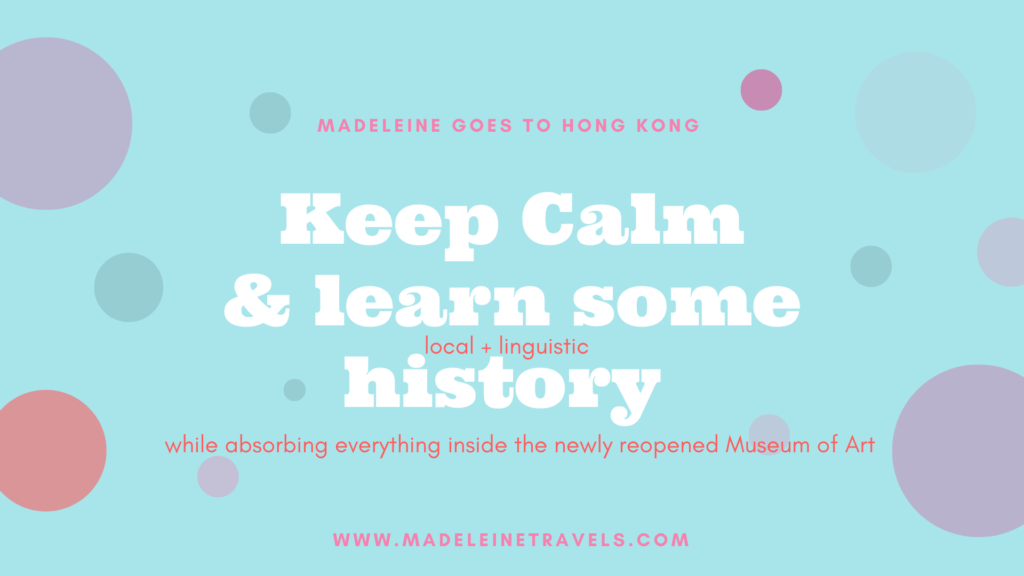[An early April update: Hong Kong Museum of Art has opened up some of its multimedia collections online in its virtually@HKMoA initiative while the museum is itself still closed to public access.]
We at Madeleine’s have been spending time in a city where there is definitely a siege-like feel: shops have shorter hours, office-workers are working from home, restaurants and shops are empty, worries about the Coronavirus are ever-present and the aftermath of the anti-extradition law protests are still lingering very much.
Yes we are talking about Hong Kong where the only consolation comes when we hear from friends managing offices in Shanghai having even less fun, having to implement IT solutions (that are meant to track the movement of staff) and make all kinds of decisions that most managers never expected to have to make.
We just heard today that people are doing more expeditions to the countryside these days (instead of working or shopping or eating at crowded places) although we do not have any data at hand! Of course, conference cancellations have been turning up in most office workers’ email inboxes for a few weeks already; even some conference calls with the US, with Japan, with Singapore, and so on, have been affected due to travelers returning from China and having to comply with the 14-day quarantine requirement.
Well, what do we at Madeleine’s and our friends recommend under the circumstances?
Well, to paraphrase what we recommended a little while back, that you should keep calm and learn some medical history, we wanted to share our love for this city with a few thoughts on the newly re-opened Museum of Art in Tsim Sha Tsui (after renovations that saw it closed for 4 years).
We say: keep calm and learn some local and linguistic history while absorbing everything at the newly reopened Museum of Art (even if you have to note that the museum is closed til 2 March 2020, one has to plan … in fact one now has time to plan!).
Oh, for sure we hate the awful entrance with the bag screening machines and apparently the number of galleries has increased from seven to 12, but there are at least 5 things we recommend about the re-opened Museum:
- We love the Wu Guanzhong rooms … this museum has been very fortunate to have seen a few donations from the artist himself: seeing his art just expands your mind and nourishes your soul. It’s a great start to the new year. On this “revisit”, we said our hellos to some of the most iconic Wu paintings (like “Two swallows”) but we also came face to face with a work we don’t remember seeing before (apparently it was only given to the museum in 2018): and it says: 仰望: 山外青山楼外楼; 橫看:起伏人生,水陸兼程 which can probably be translated as “Look forward you see mountains beyond mountains, look widely and you see the ups and downs of life and land and the sea”.
- There’s this new section on the top floor, called “Classics Remix: The Hong Kong Viewpoint”, and there’s a part of it that is about the city’s different districts and areas, where we spied a cool comment about Mongkok: Mongkok did not exist as a district even 100 years ago. The area belonged to Yau Ma Tei district, with the railway station there known as Yau Ma Tei station, serving as a cargo terminal and a livestock wholesale market . Apparently the Mong in MongKok was a different Chinese character that means “look”, as merchants should “look” for the landmark “kok” when they passed through the area. Later, the word “Mong” was pronounced as “Wong” – which means “busy” – by Cantonese speakers. Before the Second Sino Japanese War, Mong Kok remained a quiet place with a small population; it quickly flourished after the war when the name was changed, becoming busier, just as the name suggests!
- Of the “special exhibition” that was on, British art from Turner to Hockney (with works from the Tate Britain), we especially loved one work that also surprised us. Paul Nash’s “Landscape from a Dream” has a hawk looking into a mirror near which stands the framework of an empty screen, and with spheres in the mirror “representing aspects of the soul”. We didn’t know much about British surrealist painters, but this was almost as interesting as the Dali paintings we have seen in Florida and in Spain as well as the Chirico Museum in Rome.
- The yellow-and-green, you-won’t-miss-it “pineapple bun” van just outside the Museum’s entrance, with the buns priced at between HK$22 and HK$35 – very good value for a light lunch – and quite uniquely Hong Kong!
- We love that the museum is next door to many wonderful things: the beautiful harbourfront, the Star Ferry, the Space Museum (yes that wonderful half-dome), as well as all the eateries in Tsim Sha Tsui.





